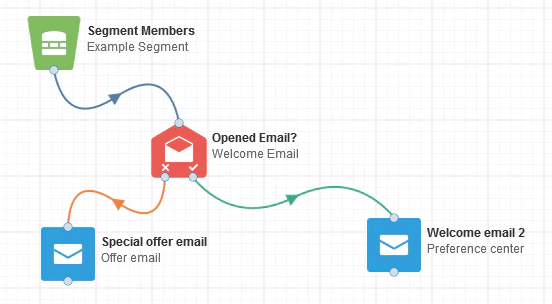Why the marketing campaign is dead and what should replace it
It's time to stop thinking in terms of campaigns. Contributor Justin Dunham says marketers need to take a more iterative approach and instead think in terms of programs -- algorithms, assets and continuous optimization.
 Remember WhatsApp? They built a $20 billion company — without running a single marketing campaign. As AOL co-founder Steve Case noted on Mashable:
Remember WhatsApp? They built a $20 billion company — without running a single marketing campaign. As AOL co-founder Steve Case noted on Mashable:
[blockquote] WhatsApp built its massive audience with no traditional advertising or marketing. They just created an awesome app and made it compelling enough (and easy enough) for people to tell their friends.[/blockquote]
Do I think this strategy would work for most companies? Probably not. But the point is that today, user acquisition and customer growth aren’t (just) about marketing. And they’re certainly not (just) about marketing campaigns.
Instead, successful marketing is about building assets and systems that drive growth — whether that’s an amazing customer service experience, a growth hacking mindset or an incredible product.
Programs, not campaigns
Many marketers think in terms of campaigns. Start with an idea or product, come up with a marketing plan, develop the messaging and creative, and you’re done. The problem is, once you’re finished, you’re already chasing the next campaign. (I’ve copied the idea for this diagram, and the following, from consultant Steve Seager.)

When you run a campaign, you get a temporary boost in your key metrics. But mostly, you can expect to go back to where you started once the effects of your campaign have worn off. Rare is the campaign that’s truly evergreen, that stays relevant forever. But compare a more iterative approach:

The iterative approach gives you better results over the long term. And today, marketers can iterate much more easily — we have data about what works and what doesn’t, and that data comes to us in real time; we don’t need to wait months, or even minutes, to start thinking about the next iteration.
The way to get out of this trap is to think about marketing in terms of programs — algorithms, assets, ongoing optimization — rather than as campaigns.
Why programs work
Why are programs the right way to think about modern marketing? Four reasons.
1. Data is key to effective marketing
Let’s take paid search as an example. For paid search to work well, you need lots and lots of data about:
- what keywords are effective.
- how you should bid on them.
- how your landing pages are working.
- and so on.
This data can only be accumulated with time and consistency. And it’s not just you who accumulates data — it’s Google, too. Google learns over time how well your ads are working and who it can show them to most effectively. And it calculates its “quality score” — which directly influences how much an ad costs you to run — based on the behavior it sees from your website visitors.
The need to gather data is key for any digital marketing effort — whether it’s search marketing, website performance or marketing to your database.
2. Evergreen content rules
Think about all the steps that go into producing a single digital asset — copywriting, graphic design, production, marketing automation and so on. It can easily take dozens or even hundreds of hours.
Given this level of investment, it’s much better to have evergreen content that can be improved over time, rather than something that just targets in the moment, like a campaign.
And meanwhile, since 51 percent of website visits are through organic search, your content can be much more effective if it has time to accumulate backlinks and traffic. As HubSpot notes:
[blockquote] Over its lifetime, one compounding post creates as much traffic as six decaying posts. A single compounding post provides a much higher return on effort to better target leads and are intended to generate sales. [/blockquote]
Rather than relying on the initial surge of traffic, sales or inquiries for a single campaign, invest in evergreen content. Start focusing on improving the landing page and honing audiences.
3. You can — and must — iterate
It used to be that you had to launch a campaign and never touch it again — imagine trying to update a direct mail campaign after you’ve already sent it. But digital allows (and indeed requires) constant iteration and responsiveness.
This can apply to any program you run long-term — paid search requires constant optimization, as does your website content and your email marketing. But one-off campaigns just don’t allow for the constant adjustment that’s required to be successful.
4. The scale of modern marketing requires a systems approach
Lastly, digital marketing today is all about scale. You can potentially reach billions of customers with very little effort, so you have to be efficient about communicating with them.
Marketing isn’t about manual segmentation anymore; it’s about building algorithms — software — to communicate in effective ways at scale.
The example that comes to mind is a nurture track, the set of emails you might get when you first sign up for a product or indicate interest in something a particular company offers.
Nurture tracks are automated, and once you’ve invested the time in setting them up, the cost to add someone else to them is zero. They’re a great example of marketing at scale, and marketers who are building them are really just writing code.

Is marketing like software engineering?
Is the marketing campaign literally gone for good? Of course not. It will be with us for a long, long time.
But increasingly, successful marketers are building systems for growth, rather than thinking about how to hit this month’s lead target.
In that way, marketing is becoming a little bit more like writing software. Efficient digital marketers are building codebases that can be incrementally improved on over time. These “codebases” bring people to your product and help them get value out of it.
The codebase includes collateral, brand, and design, of course. And it includes the workflows that run your email marketing, the rules that you follow to optimize your spend, and even the actual HTML, CSS and back-end code that run your website.
We shouldn’t become software engineers — but since we’re all managing software, we have a lot to learn from them.
Contributing authors are invited to create content for MarTech and are chosen for their expertise and contribution to the martech community. Our contributors work under the oversight of the editorial staff and contributions are checked for quality and relevance to our readers. MarTech is owned by Semrush. Contributor was not asked to make any direct or indirect mentions of Semrush. The opinions they express are their own.
Related stories